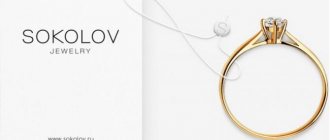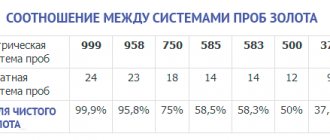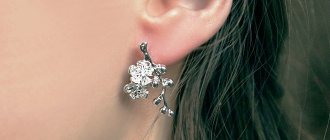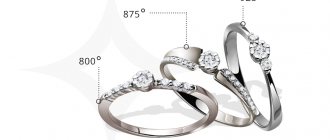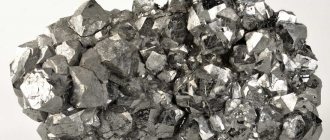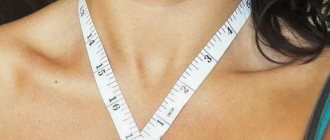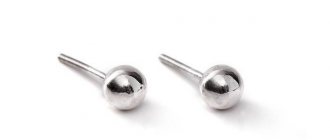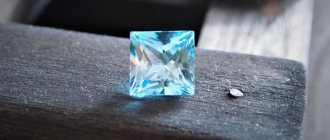11.11.2019
There are many ways to check the authenticity of gold at a pawnshop. An experienced appraiser will be able to determine in a few minutes what kind of gold he is holding in his hands, name the amount of impurities, and in some cases, the year of manufacture of the jewelry.
Pawnshops often use several ways to find out whether a client brought a counterfeit, claiming a significant loan. The most common methods are visual inspection, magnets, reagents and special devices. Let's look at how effective each of these methods is.
How to check gold when buying
In stores, they carefully check the gold standard and offer goods for sale only of the appropriate quality. But people often purchase jewelry from private individuals, since in such cases they offer products much cheaper. At the same time, there is a possibility of buying a fake that looks similar to pure precious metal. This practice exists in Russia, despite the strict control of authorized bodies.
A cheap analogue of gold is pyrite or gold-plated copper. They are similar to precious metals in appearance and physical properties. Counterfeits can usually be easily identified by visual inspection by an experienced professional. The most common mistakes made by scammers are poorly designed numbers on the stamp. The specialist will also immediately determine the costume jewelry and gilding, as well as the level of alloys.
If necessary, the master applies surface cleaning: if the jewelry is dirty, painted or treated with chemicals. In this case, the top layer is carefully cleaned using a scraper, needle file or file. Then a special substance is dripped onto this place and left for a certain time.
State supervision of gold
In 1700, Peter I carried out a monetary reform, after which state testing of products made of precious metals began. In the 1720s, the first “assay tents” were organized in Moscow and St. Petersburg.
The State Assay Supervision Inspectorate (GIPN) acquired its current name in 1940.
GIPN is the only institution in Russia where it is possible to test and mark jewelry . Only the Assay Supervision Inspectorate will tell you what grade of precious metal alloy is in your product with an accuracy of thousandths.
Procedure
A specialist will tell you how gold is checked in a pawnshop and what is needed for this. It is recommended to carry out the procedure even if the owner does not plan to sell it, in order to ensure its value. The verification is free and fast. The result will be reliable, since the process is carried out carefully and standardly consists of several stages:
- Determination of gold standard. At the same time, the specialist correlates the numbers on the mark with international standards. If the mark is missing, the appraiser will use alternative verification methods.
- Determination of the sample can be carried out by cutting the product and exposure to a chemical substance with an acidic composition. The reaction of the precious metal makes it possible to identify the sample - if the crack turns brown, the gold has a sample value below 585. If there are no changes, then the gold is expensive and of high quality.
- Product weight. Mass is measured on special scales. The electronic device has an accuracy of up to 0.01 grams.
- Visual inspection. Carried out to identify possible damage. If the jewelry is broken, the value will decrease significantly. The products are assessed as scrap.
- Presence of stones. Gemstone inserts significantly increase the price.
Try
The sample will tell the appraiser the basic information about gold jewelry. This is the first thing pawn shop employees pay attention to when evaluating jewelry.
There are two hallmarks on gold jewelry. The first is applied by the Assay Office. A sample in the shape of a spatula indicates that the jewelry was legally sold in Russia. A woman’s head in a kokoshnik or a star can be depicted on the shoulder blade. Next comes the sample itself: 375, 500, 585, 750. This number will tell you the amount of impurities in the jewelry. Thus, a 585 sample item will consist of 58.5% pure gold, the rest being impurities. After the digital sample there may be a code of the assay office that carried out the control.
The second mark is from the manufacturer. It consists of three parts:
- Year of manufacture;
- Inspection code, similar to the first mark;
- Manufacturer code.
It happens that the sample is impossible to see, or it simply does not exist. For example, you bring as collateral an old, expensive item where the hallmark has already worn off. In addition, there is a possibility that the sample was tampered with. Then other methods of checking gold come to the aid of the pawnshop appraiser.
Gemstone Testing
Products with stones are most valuable. Knowing how to test gold, it is useful to familiarize yourself with the procedure for testing stones. In a pawnshop, the procedure is carried out according to the global 4C methodology for four indicators:
- mass of stone;
- color;
- purity;
- cut.
The weight of the material is measured in carats. Stones are small - less than 0.29 carats, medium - less than 0.99 and large - more than 1 carat. This indicator is determined by weighing and subsequent visual inspection using a magnifying device.
The color is clearly visible if you place the stone on a white piece of paper or plastic. In this case, gemological lighting with white rays is used.
The most important criterion for a stone is purity. To identify it, GOST tables have been developed. There are 12 purity values. Stones with severe damage are of least importance. Cracks that are visible at 10x magnification or with the naked eye are taken into account. Higher magnification is not used to evaluate purity. Scratches can be on the surface of the material or inside.
To evaluate the cut, a scale with graduations A-G is used. The methodology was developed by GOST. This parameter is subjective, since the same cut may attract one consumer and not appeal to another. But often a product is purchased based on its cut.
A complete gold inspection includes an assessment of the precious metal and stone, mounting option, appearance of the product, manufacturer and level of wear. How the gold is checked at a pawnshop determines whether the owner will be able to sell it at a decent price. At home, it is impossible to accurately determine the quality of the decoration. Therefore, it is worth resorting to the help of professionals.
Types of reagents and their effect on gold alloys
Testing of gold jewelry is carried out using several types of reagents. Each of them is used for a specific alloy and has a characteristic effect on it.
Chlorine gold
Gold chloride is a reagent used for testing jewelry without specifying samples. Thus, you can find out whether the alloy being tested contains precious metal and in what quantity.
Gold chloride is suitable for detecting counterfeits. With its help you can distinguish real gold from gilding and costume jewelry. In addition, the reagent is applicable for white precious metal 500, 583/585.
When choosing a chemical for testing jewelry, you need to know that it only works on alloys with a gold content of up to 60%.
Acidic reagents
Acid compounds for testing precious metals are a mixture of nitric and hydrochloric acids in various proportions. Distilled water is added to them. For example:
- nitric acid density 1.5;
- hydrochloric acid, density 1.20;
- distilled water.
The amount of reagents directly depends on the samples of the alloys being studied.
The effect of acid reagents on gold is of two types. On some products they leave a light stain, on others they do not have any reaction. The chemical element does not affect high-grade alloys or leaves dark marks on them.
Each acid reagent corresponds to a specific sample for analysis: 375, 750, etc. The lower the gold content in the alloy, the more pronounced the color of the reagent stain.
Acidic reagents for gold determination
When testing gold alloys of 375, 500, 750 standard, acid-containing preparations leave a transparent drop on the cleaned area without any trace. In rare cases, a subtle light shadow appears.
If the reagent is dropped onto a product made of base metal, a certain reaction will begin on its surface, followed by bubbling and the appearance of a greenish precipitate. A specific unpleasant odor will also appear.
Potassium iodide solution
The product is used to test alloys with a high content of precious metals. This chemical is used to detect counterfeit metals that are resistant to other reagents. The reagent with a solution of potassium iodide does not work on alloys whose fineness starts from 900. On a product with a mark of 800 and on jewelry with high chemical resistance, a black or green spot will form with possible subsequent bubbling.
How to check gold in a store
Using special instruments you can also check the quality of precious metals. Their action is to measure the electrochemical potential.
Most often, the material is checked using electronic testers. Inside the device there is a liquid with which the product is processed and its compliance with standards is determined. If it is possible to conduct laboratory tests, the full composition of the alloy can be determined. In this case, the X-ray method and a spectrometer device are used. The jewelry is placed in a scanning chamber. The chemical composition will be calculated by the computer and displayed on the monitor.
As available tools for self-testing, the following are suitable:
- vinegar, in which false gold will tarnish;
- a magnet to which the precious metal is not attracted;
- porcelain, on which yellow traces of gold remain;
- glass on which no traces will remain if you run a precious metal over it;
- iodine, which leaves dark marks on gold.
It is advisable to carry out testing for each decoration. This will allow you to ensure its quality so that you can sell it profitably or wear it yourself.
5 / 5 ( 2 voices)
about the author
Evgeniy Nikitin Higher education majoring in Journalism at Lobachevsky University. For more than 4 years he worked with individuals at NBD Bank and Volga-Credit. Has experience working in newspapers and television in Nizhny Novgorod. She is an analyst of banking products and services. Professional journalist and copywriter in the financial environment [email protected]
Is this article useful? Not really
Help us find out how much this article helped you. If something is missing or the information is not accurate, please report it below in the comments or write to us by email
How to find out the hallmark of a gold product at home: Archimedes' method
To carry out the test, we will need electronic scales, a calculator, and water. The method is based on Archimedes' law, according to which we determine the density of the product and compare it with the standard. To calculate, we need to know the weight of the product and the weight of the displaced liquid. Then perform a mathematical operation and compare it with the table of metal densities. More similar, it is described in the video - how to determine real gold and its purity by water:
Precious metal density table:
| metal | Silver | Gold 375, 500 | Gold 583, 585 | Gold 750 | Gold 999 |
| density | 9 — 10 | 11 — 12 | 12 — 14 | 14 — 17 | 19,3 |
Comments: 0
Your comment (question) If you have questions about this article, you can tell us. Our team consists of only experienced experts and specialists with specialized education. We will try to help you in this topic:
Author of the article Evgeny Nikitin
Consultant, author Popovich Anna
Financial author Olga Pikhotskaya
Chemical reactions of various gold samples to reagents
The table below shows the reactions of alloys of various samples to one or another reagent.
| Reagent/Sample | Chlorine gold | Acids | Potassium iodide |
| Below 375 | dirty dark green, gray-green spot | dirty dark green, gray-green spot | — |
| 375 sample | greenish-brown spot | — | — |
| 500 carat yellow gold | light brown spot | the drop remains transparent. Chestnut stain when using 585 sample reagent | — |
| 500 white gold | spots of different shades of brown | spots of different shades of brown | — |
| 585 yellow gold | transparent drop | bright spot | — |
| 585 white gold | golden stain | beige, golden or orange spot | — |
| 750 yellow gold | barely perceptible stain | barely perceptible stain | — |
| 750 white gold | light brown spot | light brown spot | — |
| 800 and 900 samples | — | — | dark red spot |
Safety precautions when working with chemicals
Chemical reagents are quite aggressive substances, so when working with them you must adhere to certain safety rules. This is especially true for the use of acids.
You need to lay a thick fabric on the surface where the testing procedure will take place. Hands are protected with gloves, clothing with an apron. Acids are diluted in a special container, added in a thin stream to distilled water. The liquid may become hot. Before using the composition on gold, it must be cooled.
Application and technique of working with touchstone
In addition to chemical reagents, you can test a sample of a precious metal with a touchstone. The mineral of natural origin belongs to the group of silicon shale and contains about 8% carbon, which gives it a black color. There are also artificial touchstones.
The use of a tool begins with its preparation. The surface is wiped with castor oil, then rubs are applied - dense strips no more than 2-3 mm wide and up to 20 mm long. Vertical lines are applied nearby using standard needles that correspond to a particular sample. The rubs are moistened with reagents and the reaction is observed. A dark precipitate in comparison with the reagent indicates a low gold content in the alloy, a light one, on the contrary, indicates a higher one.
The advantages of testing jewelry on a touchstone are the preservation of its integrity, the testing of any alloys, and the simplicity of the procedure.
Buying reagents for gold will be a justifiable expense if they are used in a workshop or pawnshop. For home testing, less complex materials are suitable. In addition, the person conducting the testing must have certain skills, because reagents are expensive, and their wasteful use can hit your pocket.
